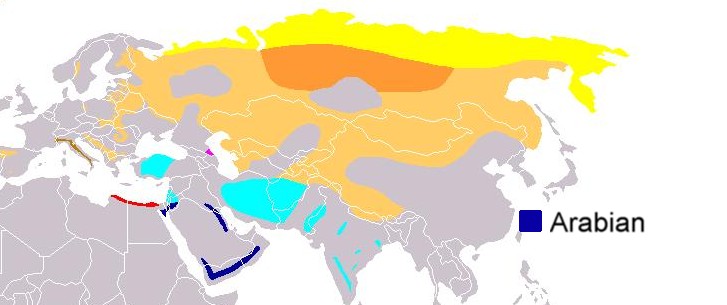- Arabian Wolf
Taxobox
name = Arabian Wolf

image_width = 250px
status =
regnum =Animal ia
phylum = Chordata
classis =Mammal ia
ordo =Carnivora
familia =Canidae
genus = "Canis "
species = "C. lupus"
subspecies = "C. l. arabs"
trinomial = "Canis lupus arabs"
trinomial_authority = Pocock, 1934 [ITIS|ID=726811 |taxon="Canis lupus arabs" |year=2007|date=27 October]
range_
range_map_width = 250px
range_map_caption = Arabian wolf rangeThe Arabian wolf ("Canis lupus arabs") is a
subspecies ofGray Wolf which was once found throughout theArabian Peninsula , but now only lives in small pockets in SouthernIsrael ,Oman ,Yemen ,Jordan ,Saudi Arabia , and probably in some parts of theSinai Peninsula inEgypt .Features and adaptations
The Arabian wolf is a small, desert adapted wolf that stands at around 26 inches shoulder height and weighs an average of 40 pounds Their ears are proportionally larger in relation to body size when compared to other species, an adaptation needed to disperse body heat. Also, Arabian wolves do not live in large packs, and instead hunt in pairs or in groups of about three to four animals. This subspecies is unusual, as it is not known to howl. [cite book | author = Lopez, Barry | title = Of wolves and men | year = 1978 | pages = pp.320 | id = ISBN 0743249364] . Arabian wolves have short, thin fur in summer, though the hair on their back remains long even in summer. It is thought that this is an adaptation against solar radiation. The winter coat is long, though not as long as northern subspecies.cite book | author = Fred H. Harrington, Paul C. Paquet | title = Wolves of the World: Perspectives of Behavior, Ecology, and Conservation | year = 1982 | pages = pp.474 | id = ISBN 0815509057] Arabian wolves are unique among grey wolves due to the middle two toes of their paws being fused, a trait originally thought unique to the
African Wild Dog .cite book | author= Macdonald, David | title=The Velvet Claw | year=1992 | pages= 256 | id=0563208449 ] Like other wolves, the Arabian wolf's eyes are yellow, but many are found with brown eyes — a certain indication that a portion of the population is not of pure blood anymore and that their ancestors have interbred with feral dogs. This poses a very serious threat to the survival of this subspecies.Verify source|date=August 2008Fact|date=August 2008It is distinguished from the
Iranian Wolf by its paler fur, smaller size and proportionally smaller head.cite book | author= Bright, Michael | title=Beasts of the Field: The Revealing Natural History of Animals in the Bible | year=2006 | pages= p346 | id=1861058314 ]Diet
Arabian wolves will attack and eat any domestic animal up to the size of a goat. As a result, farmers will not hesitate to shoot, poison, or trap them. Arabian wolves also feed on hares, rodents,
ungulates , and anycarrion they can find.Arabian wolves will hunt small to medium sized animals such as
cape hare s,Dorcas Gazelle s andibex es, though they will feed on carrion and livestock when in the vicinity of human settlements.cite web | title = Group Size and Home Range of the Arabian Wolf (Canis lupus) in Southern Israel | work = American Society of Mammalogists | publisher = JSTOR | url = http://links.jstor.org/sici?sici=0022-2372(199905)80%3A2%3C611%3AGSAHRO%3E2.0.CO%3B2-L | accessdate = 2007-09-02]Current status
In Oman, the wolf population has increased significantly since hunting was banned, and there is a strong possibility that they will naturally reestablish themselves in certain places within the region in the relatively near term. In
Israel , there are between 100 and 150 Arabian wolves all over theNegev and the Ha'arava.In culture
The wolf was frequently mentioned in the
Scriptures as an enemy to flocks (Sirach 13:21;Matthew 7:15), and an emblem of treachery and ferocity, and bloodthirstiness. The tribe ofBenjamin , owing to its warlike character, was often compared to a wolf in the Old and New Testiment of the Bible.References
Wikimedia Foundation. 2010.
